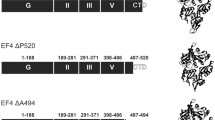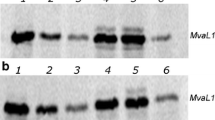Summary
Initiation factor F3 has been purified fromEscherichia coli and labelledin vitro by reductive alkylation. The14CH3−F3 so obtained had a specific activity of about 1 000 cpm/μg and was shown to have retained its biological activity. Labelled F3 binds to 30S ribosomal subunits ofEscherichia coli andBacillus stearothermophilus, but does not bind to either 70S ribosomes or 50S ribosomal subunits. The stoichiometry of the binding indicates that one molecule of14CH3−F3 is bound to each 30S ribosomal subunit. Several antibiotics, known to interact with 30S subunits, inhibit the binding. Functional studies indicate that F3 is released from 30S ribosomes as a result of the formation of the “70S initiation complex”.
Similar content being viewed by others
References
Berissi, H., Groner, Y., Revel, M.: Effect of purified initiation factor F3 (B) in the selection of ribosomal binding sites on phage MS2 RNA. Nature New Biol.234, 44–47 (1971).
Davis, B. D.: Role of subunits in the ribosome cycle. Nature (Lond.)231, 153–157 (1971).
Dubnoff, J. S., Maitra, U.: Isolation and properties of polypeptide chain initiation factor FII fromEscherichia coli: evidence for a dual function. Proc. nat. Acad. Sci. (Wash.)68, 318–323 (1971).
Friedman, S. M.: Protein-synthesizing machinery of thermophilic bacteria. Bact. Rev.32, 27–38 (1968).
Gualerzi, C., Pon, C. L., Kaji, A.: Initiation factor dependent release of aminoacyl-tRNAs from complexes of 30S ribosomal subunits, synthetic polynucleotide and aminoacyl-tRNA. Biochem. biophys. Res. Commun.45, 1312–1319 (1971).
Iwasaki, K., Sabol, S., Wahba, A. J., Ochoa, S.: Translation of the genetic message. VII Role of initiation factors in formation of the chain initiation complex withEscherichia coli ribosomes. Arch. Biochem. Biophys.125, 542–547 (1968).
Kaempfer, R.: Control of single ribosome formation by an initiation factor for protein synthesis. Proc. nat. Acad. Sci. (Wash.)68, 2458–2462 (1971).
Lee-Huang, S., Ochoa, S.: Messenger discriminating species of initiation factor F3. Nature New Biol.234, 236–239 (1971).
Lodish, H. F.: Specificity in bacterial protein synthesis: Role of initiation factors and ribosomal subunits. Nature (Lond.)226, 705–707 (1970).
Lowry, O. H., Rosebrough, N. J., Farr, A. L., Randall, R. J.: Protein measurement with the Folin. phenol reagent. J. biol. Chem.193, 265–275 (1951).
Pestka, S.: Inhibitors of ribosome functions. Ann. Rev. Microbiol.25, 487–562 (1971).
Revel, M., Greenshpan, H.: Specificity in the binding ofEscherichia coli ribosomes to natural messenger RNA. Europ. J. Biochem.16, 117–122 (1970).
Revel, M., Lelong, J. C., Brawerman, G., Gros, F.: Function of three protein factors and ribosomal subunits in the initiation of protein synthesis inEscherichia coli. Nature (Lond.)219, 1016–1021 (1968).
Rice, R. H., Means, G. E.: Radioactive labeling of proteinsin vitro. J. biol. Chem.246, 831–832 (1971).
Sabol, S., Ochoa, S.: Ribosomal binding of labelled initiation factor F3. Nature New Biol.234, 233–236 (1971).
Sabol, S., Sillero, M. A. G., Iwasaki, K., Ochoa, S.: Purification and properties of initiation factor F3. Nature (Lond.)228, 1269–1273 (1970).
Vermeer, C., Talens, J., Bloemsma-Jonkman, F., Bosch, L.: Studies on the ribosomal initiation factor F3. Multiplicity of F3 and DF activities. FEBS Letters19, 201–206 (1971).
Vogel, Z., Vogel, T., Zamir, A., Elson, D.: The protection by 70S ribosomes of N-Acyl-aminoacyl-tRNA against cleavage by peptidyl-tRNA hydrolase and its use to assay ribosomal association. Europ. J. Biochem.21, 582–592 (1971).
Author information
Authors and Affiliations
Additional information
Communicated by H. G. Wittmann
Rights and permissions
About this article
Cite this article
Pon, C.L., Friedman, S.M. & Gualerzi, C. Studies on the interaction between ribosomes and14CH3−F3 initation factor. Molec. gen. Genet. 116, 192–198 (1972). https://doi.org/10.1007/BF00582228
Received:
Issue Date:
DOI: https://doi.org/10.1007/BF00582228




